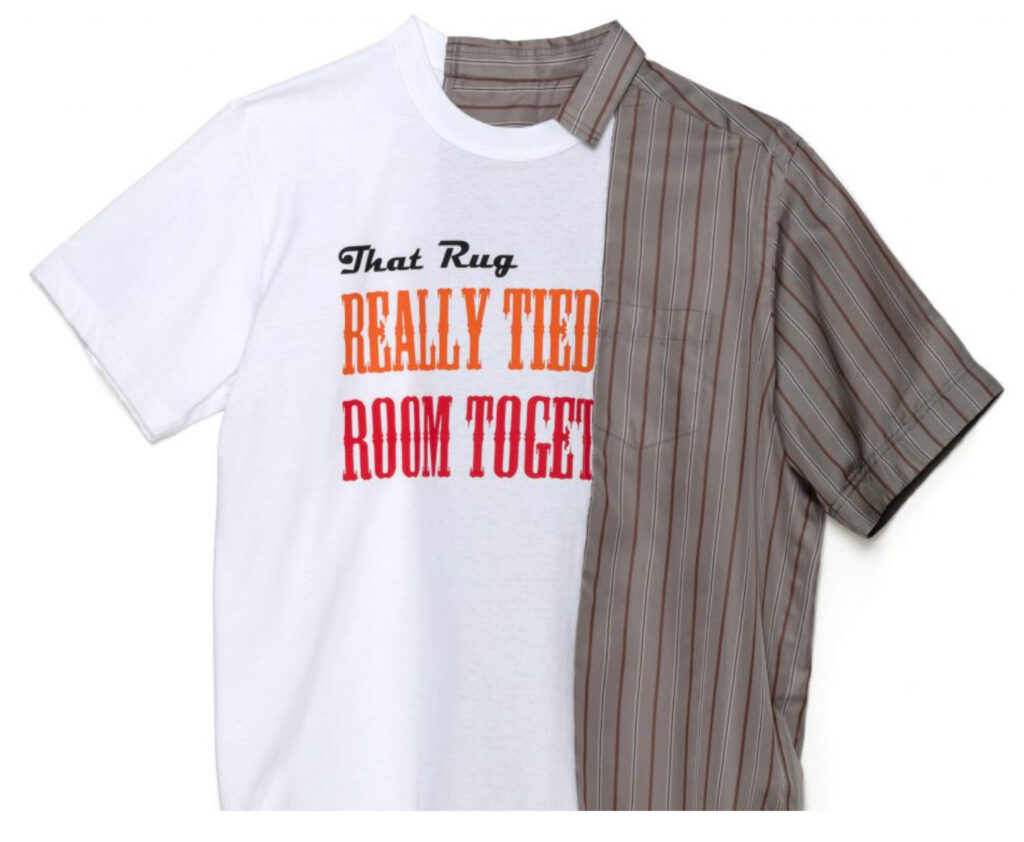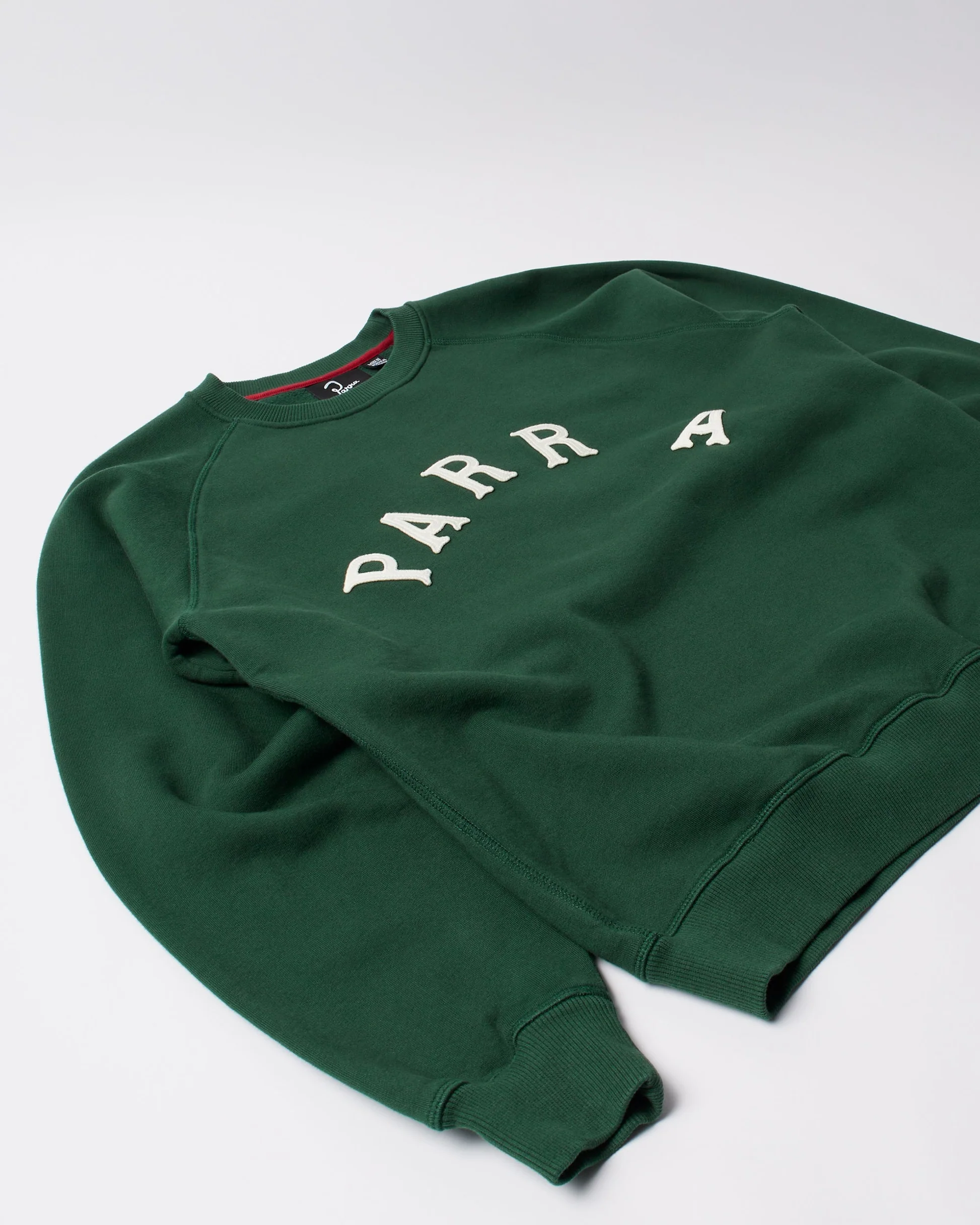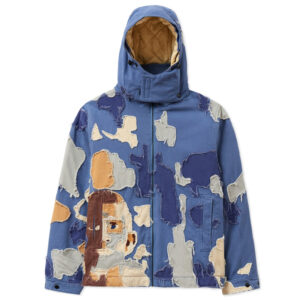In the ever-evolving landscape of fashion where nostalgia and subversion are common currencies, sacai remains a rare voice that doesn’t merely borrow from pop culture—it reinvents it. In 2025, Chitose Abe and her formidable Tokyo-based label return with an audacious update to one of their most unexpected connections: sacai × The Big Lebowski. Originally debuted as part of the Spring/Summer 2020 collection, the partnership brought cult cinema into the vocabulary of hybridized fashion. Now, half a decade later, Abe returns to The Big Lebowski with a fresh drop that doesn’t just revisit—but re-scripts the entire premise of the original capsule.
The renewed collection arrives not simply as merchandise or fan tribute. It is, rather, a wearable exercise in conceptual dislocation—recontextualizing The Big Lebowski’s comedic nihilism through sacai’s architectural sensibility and love of textural contradiction. The result: garments that speak the language of confusion, irony, elegance, and tension. In other words, precisely what both sacai and the Coen Brothers have always done best.
The Absurd Made Textile
At its core, The Big Lebowski is a film about nothing and everything at once—a hardboiled noir parody soaked in bowling alleys, bathrobes, and White Russians. But its enduring cult status lies in how it blends the banal with the mythic, the stupid with the profound. In bringing this atmosphere into her 2025 collection, Abe performs more than homage; she translates cinematic narrative into sartorial uncertainty.
The newly updated T-shirts—centerpieces of this resurfaced collaboration—maintain sacai’s now-signature DNA: the unexpected pairing of opposing materials and asymmetric construction. Think faded movie stills screen-printed across shirt panels that abruptly shift into crisp oxford cloth or split open with sacai’s iconic side zippers. These aren’t just tees with film references—they are wearable narrative disruptions.
The prints reference key moments and characters: Walter’s iconic sunglasses, The Dude’s floppy cardigan, the nihilists floating in robes through a surreal dream sequence. But instead of nostalgia, the garments read like a fragmented screenplay—jumps in time, spliced scenes, and moments lost in translation. It is the cinema of confusion, materialized.
20 Years Later: Cult Film Becomes Fashion Canon
Released in 1998, The Big Lebowski was initially a commercial shrug, a critical head-scratcher. But its unconventional tone, deadpan delivery, and slacker-philosopher protagonist eventually cemented it as a generational touchstone. Today, the film is not only a cult classic but a semi-religious experience (see: annual Lebowski Fests), and its influence on fashion—whether consciously or not—has been surprisingly extensive.
The Dude’s anti-style style—bathrobes, jelly sandals, oversized cardigans—became a meme, then a moodboard, then a legitimate design reference. sacai, however, doesn’t take the easy route of ironic replication. In Abe’s vision, the costume becomes couture, the absurd becomes architectural, and The Dude’s laissez-faire wardrobe is reconstructed through the lens of Japanese craft and avant-garde structure.
The 2025 update comes at a time when fashion, more than ever, is interested in self-aware commentary. This collection doesn’t just wear The Big Lebowski on its sleeve—it interrogates its ethos. What does it mean to not care in an age of hyper-caring? Can leisurewear still symbolize protest? What happens when slacker culture is reengineered into objects of luxury?
Material Tension and Narrative Interruptions
sacai’s hallmark design method involves tension—between form and fluidity, structure and spontaneity, polish and decay. The updated Big Lebowski pieces manifest this ethos in full clarity. One standout piece features an oversized tee with a pixelated image of The Dude sprawled on a Persian rug, overlaid with semi-sheer cotton shirting and punctuated with an industrial zipper slicing diagonally across the torso. It’s as if the garment itself is in disagreement with its subject matter—dressed up and dressed down, stitched together yet refusing cohesion.
The collection revels in its contradictions. Velvet panels collide with mesh. Linen interacts with matte nylon. Jersey fabrics—reminiscent of old bowling shirts—are rerouted with lace insets or micro-pleats. The colors, meanwhile, stay within the visual vernacular of the film: sandy neutrals, vintage browns, dingy greens, and the occasional burst of dream-sequence neon. These are clothes that are both scene and set dressing, object and observer.
sacai’s Broader Dialogue: Culture in Layers
This collaboration isn’t sacai’s first foray into cinematic or pop-cultural homage. Over the past decade, Chitose Abe has found fertile ground in cultural crossovers: from sacai x Nike fusions that blend sneaker language with luxury tailoring, to Moncler capsules that mutate outerwear into haute-utility hybrids. But The Big Lebowski—with its recursive irony and philosophical deadpan—offers Abe a unique opportunity: the chance to explore narrative as textile.
In this sense, the 2025 update is more than a drop—it is a continuation of sacai’s long-standing project of cultural layering. Where some designers appropriate imagery to tap into a market, Abe seems interested in constructing the idea of culture through design itself. Her garments don’t shout with references; they whisper with contradictions. And in The Big Lebowski, she has found a muse that shrugs at meaning just as slyly as her designs often do.
The Globalization of Niche
There’s something telling about a Japanese brand interpreting an American cult film for a global luxury audience. It is, in itself, a comment on the fluidity of taste and the collapse of cultural hierarchies. What was once niche becomes canon. What was once absurd becomes aspirational.
In Tokyo, Paris, and Los Angeles alike, The Dude has become a kind of anti-hero for a generation exhausted by performance. sacai’s reinterpretation does not trivialize this figure, but neither does it canonize him. It mutates him—slices him into pieces, embeds him into stitched narratives, reimagines his presence as an abstraction. It is fashion as film remix, as collage, as cinematic tailoring.
And it’s worth noting that, unlike traditional merch or streetwear tributes, these garments don’t demand insider knowledge. They reward it, but they do not depend on it. You don’t need to know who Donny is to understand the beauty of a multi-material shirt with hidden buttons and a jarring zipper curve. But if you do know? The clothing takes on new depths—jokes become structure, dialogue becomes detail.
Nihilism as Aesthetic, Fashion as Farce
The 2025 sacai × The Big Lebowski collection doesn’t pretend to offer answers. It does not resolve contradictions or explain references. Instead, it revels in the absurdity of merging a stoner noir with precision-cut fashion. In doing so, it achieves something rare: it makes fun of its own seriousness while still taking the craft seriously.
Chitose Abe’s work has always been about tension, and this collection takes that ethos to its extreme. It is a sartorial bowling ball hurled down the lane of logic, knocking over expectations with each panel, print, and fabric twist.
And somewhere, one imagines, The Dude abides—in matte gabardine, mesh overlays, and zipper-ripped silhouettes, sipping a White Russian, indifferent to whether his likeness now hangs in a high-concept showroom in Aoyama or walks the streets of Paris.
Because, after all, fashion, like life, is about how you wear it when things get weird.
No comments yet.









